Seven Animal Stories, reviewed by the author
Dragana Grozdanić, Croatia
Dragana Grozdanić works primarily as an English teacher and a literary translator, but also produces ELT materials. She holds an MA in English literature. Her publications include Word for Word, an interactive picture dictionary with accompanying CD, Domino Dictionary, a multilingual dictionary with domino cards, Welcome to the Word World, a book of vocabulary games, Test Your English Tenses, a book of grammar exercises, English Here, English There, English Everywhere, a book of 1001 quiz questions on intercultural topics, My First English Words and See-Saw-Seen, learning aids. The work reviewed here is titled The Seven Animal Stories, a series of picturebooks suited for primary school children, which includes the following stories: Two Playful Lions, Where is the Squirrel’s Necklace? The Hedgehog and the Frog, The Little Bear and the Mobile Phone, The Most Beautiful Giraffe, The Cat from MixMax and The Mouse who Hated School. Dragana Grozdanić has also recently published English grammar in quizzes, Never Give Up!
E-mail: dgrozdan@globalnet.hr

Menu
About the picturebooks
The Seven Animal Stories series – written with second language learners in mind
Why stories? An innate love of reading and listening to stories
The initiative for writing the stories
Present tense narration – a stepping stone
What the stories are about – contents plus vocabulary & grammar structures
Post-reading activities / the special focus on My Creative Corner
How and when to use these picturebooks – 'letting the students’ imagination roam free while having their hands full’
Visual impact of the stories
The Seven Animal Stories series seen by a reviewer
Books for both experienced teachers and teachers with little or no experience
Published by Školska knjiga, Zagreb, Croatia, 2006/2007
Copies are available through the publisher’s website: www.skolskaknjiga.hr or www.dominovic.hr, the online bookshop
Seven Animal Stories are a series comprising seven educational picturebooks - early readers, aimed at motivating children to read in English and learn English in a fun way. The books are developed specifically for children (aged 7 – 12) learning English in primary schools and they are written with second language learners in mind. The stories are followed by post-reading activities and can be read by children who learn English as a second language, as well as by children whose mother tongue is English. One of the benefits of these picturebooks is that they are suitable for teaching English to young learners and for learning English in an interesting and fun way. They are also useful for learning about shared moral norms and values which determine the way children see themselves and interact with others. The following picturebooks form the series: Two Playful Lions, Where Is the Squirrel’s Necklace? The Hedgehog and the Frog, The Little Bear and the Mobile Phone, The Most Beautiful Giraffe, The Cat from MixMax and The Mouse Who Hated School.
These seven picturebooks are dedicated to my parents, to my father who, being a teacher, taught me to read, and to my mother, who told me the stories while brushing my long hair. Children have an innate love of reading and listening to stories which tell us about ourselves, other people and life in general. I tended to use and naturally incorporate into the body of the stories some more or less familiar nursery rhymes and traditional songs from the English speaking world in order to make children aware of different customs and different cultures which they can compare to their own. The stories reveal the essence of existence and expose the very core of the human being, thus overcoming cultural differences by conveying the universal truth about the world we live in. These seven educational/didactic stories about animals can be used not only for teaching/learning English all around the world, but also for teaching children about ethical norms and principles. While reading these stories, children will start thinking about themselves, about their own actions and behaviour, learning in a fun and interesting way about shared moral values that help shape an individual in the process of growing up.
Some would say that there are many wonderful and beautifully written authentic materials that can be used for teaching/learning English, so why bother writing new ones? Yes, that's true, but from a teacher's point of view such books are not always the best solution since young English learners often need something simple and easy to follow, sets of simple words, sentence structures and grammar while progressing to more demanding levels. In my opinion, although some colleagues might disagree with me, authentic reading materials, even though they might be the ultimate goal for language learners who are not native speakers of English, are not the best solution to teach foreign language learners to read. English learners do not have the privilege of knowing hundreds or thousands of words and the grammar of English when they start to read. They find reading authentic books difficult. Children interested in the story, in reading itself, often lose enthusiasm and interest when they come across difficult vocabulary or some incomprehensible sentences and grammar structures. If readers often have to look up in a dictionary incomprehensible words or try to guess the meaning of the word from the context, not always being sure whether they understand it well, they might become frustrated and in the end completely give up reading.
As a teacher, I felt the need for books which arouse readers' interest, engage them and hold their attention and at the same time help to develop their reading, writing and vocabulary skills through subtly introduced appropriate target vocabulary and grammar structures. These books were written with the aim of helping early learners become skilled and enthusiastic readers. I attempted to provide challenging material they can easily deal with text which does not prevent understanding of the story, and enjoyment in reading. It is not easy to use simplified vocabulary and simple sentence structures to match the abilities of English learners in primary schools, that is, to strike a balance between an engaging and inspiring story on one hand and appropriate language input on the other. There are always traps to fall into. It is not at all easy to write such a book which meets all these criteria, a book carefully formed in the sense that only an observant eye can notice subtly interwoven target vocabulary and structures hidden in apparently seamless texts. At first I was in doubt myself, weighing the advantages and disadvantages of such stories. Of course, I was well aware that these stories cannot be compared to stories with a natural flow of narration when the author is not under the pressure of using target vocabulary and appropriate grammar structures, but the editor, Vlasta Čeliković, had confidence in me and my abilities to do the task well. So it was worth trying. Writing the very first story I felt like a dancer, dancing with both legs in shackles, but in time I managed to dance without the shackles. After finishing the whole series I was literally dancing with joy, utterly satisfied with the project. I knew I had done a good job when I tested the stories with my students. Their reaction was proof enough. They really enjoy reading the stories which help them greatly consolidate and improve their English.
Of course, there was another stepping stone in writing these stories – the use of the narrative tense. Fortunately, I find the outcome satisfying. To be quite honest, I was doubtful when I started writing the stories. Most stories are told using the past tense. Everybody is familiar with ‘Once upon a time’ openings, but having in mind second language learners aged 7-12, who are still not well acquainted with past forms, I opted for the present tense narration, which is not so common in story writing and has its own limitations. I tried to find a method of narration that worked for the story and for my readers and I was surprised at how well the present narration stories were accepted by my students. Although the action in such stories seems immediate and readers have to believe that the events of the story are happening before their eyes, at the moment of reading, they are nevertheless in anticipation of an outcome, fully involved in the characters and the events of the plots. After testing my present tense stories in the classroom, I knew that my present tense narration was only a stepping stone on the path to success. In other words, that success was happy and enthusiastic learners reading stories for pleasure, and learning English at the same time. In one of my stories, The Little Bear and the Mobile Phone, past tense narration is used, but that story was also written with second language learners in mind.
Two Playful Lions - published by Školska knjiga, Zagreb, 2006 - 50 pages: illustr.; 23 cm. - (Seven Animal Stories)
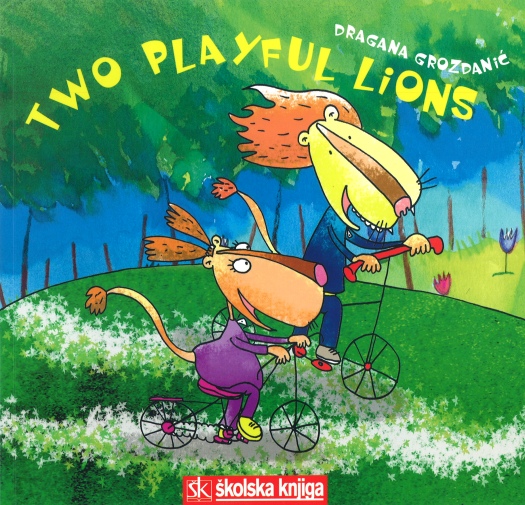
This is the story about love and forgiveness as well as about respecting gender differences. Larry and Lara are a young and playful lion and lioness. Both are great admirers of all kinds of outdoor activities, particularly basketball. Their big friendship is tested when Lara is not accepted in the basketball team because she is a female. Larry does his best to convince the other lions not to be so cruel, arguing that it is really unfair, but the other basketball players are unconvinced and unrelenting, so Lara decides to leave. She is undoubtedly hurt, but proud. In the end, sporty and persistent Lara shows that her place is among the best and she forgives her ashamed friends.
Vocabulary: sports; feelings, friendship, packing a suitcase, action words, rhyming words. Grammar: present simple (am / is / are; play / plays; doesn’t / don’t); present continuous (What are they doing now?); possessive adjectives (my, your, his, her, our, their); personal pronouns vs. possessive adjectives (they / their; she / her); comparison of adjectives; word order; Let’s…
The Cat from MixMax – published by Školska knjiga, Zagreb - 49 pages : illustr.; 23 cm - (Seven Animal Stories)
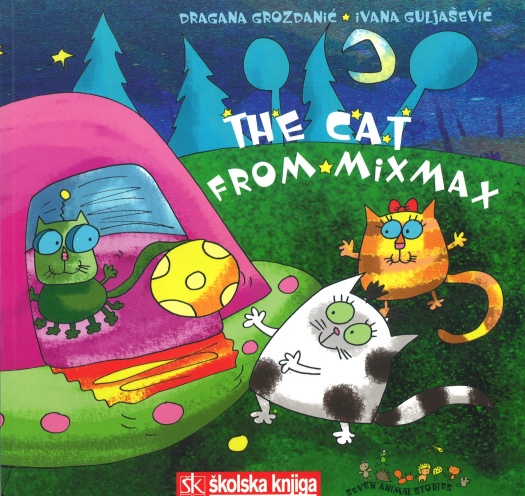
The story is about children/parents, authority and obligations
One day Zix, a rebellious green cat, arrives by spaceship from the planet MixMax. Rather, he runs away from his planet because he is fed up with living by the standards imposed by his parents. He wants to avoid their restrictions and advice and have a nice time somewhere else. On the new planet, he meets new friends, two beautiful cats named Pussy and Puffy. Zix confides in them and confesses all his concerns and worries. They become close friends and Zix has a very nice time playing with them. Although he spends three wonderful days with his new friends, the runaway Zix becomes nostalgic and starts yearning for his parents and his home. At the end he is happy to return where he escaped from.
Vocabulary: parts of the body; rooms in a house; furniture; food; healthy eating; hobbies and interests; parents and children; friendship; life on other planets; action words; rhyming words. Grammar: WH questions (Who? Where? Why? Whose? How?); plural of nouns; simple present – to be & to have; present continuous; present simple vs. present continuous; There is… / There are… : There isn’t / There aren’t; short answers: Yes, there are / No, there aren’t; must / mustn’t; word order; prepositions (with, on, in, at, for)
The Little Bear and the Mobile Phone – published by Školska knjiga, Zagreb, 2007 - 47 pages,: illustr.; 23 cm, (Seven Animal Stories)
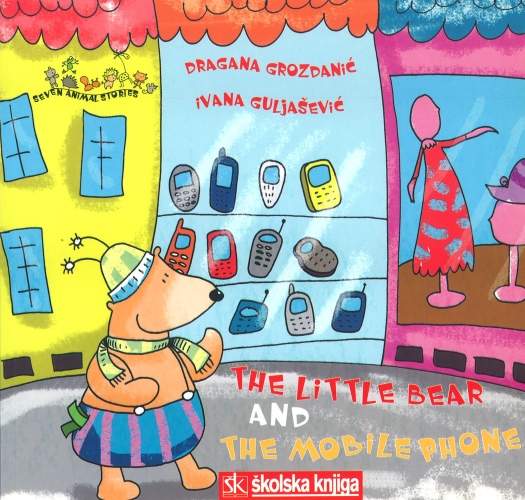
The story is about ethical values and the need always to tell the truth, no matter how painful it might be. Like Pinocchio’s nose, a lie very soon becomes apparent and obvious to others. One way or another, a deception always catches up on you. In this story, the little bear spent the money his mother gave him for his granny. He bought a mobile phone. Besides, he lied to his mother that he had been robbed on the way. His mother found out the truth. Due to ingenious and resourceful teaching methods, she taught her son a lesson about ethical norms and values, showing him that a lie definitely has no legs.
Vocabulary: forest animals; months of the year; birthday party words; action words; rhyming words. Grammar: WH words; prepositions (in December); possessive genitive (Whose birthday? Sam’s); simple past (was / were / did / regular & irregular verbs); word order
The Hedgehog and the Frog – published by Školska knjiga, Zagreb, 2007 - 52 pages: illustr.; 23 cm.
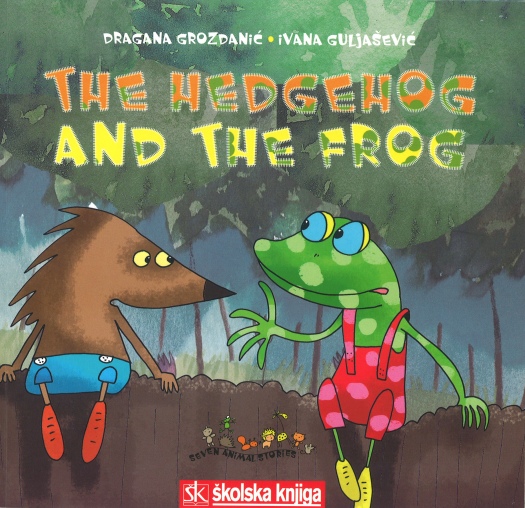
This story is about accepting differences. It encourages children to think about themselves as well as about ethical norms and principles. Not all people are equally good at everything, but that is no reason to immediately reject and judge them as inadequate. This is a story about friendship between Spiky, the hardworking hedgehog, and Hopper, the very lazy frog who constantly avoids doing homework and all other school assignments, but enjoys drawing and painting water lilies. It is a hobby that occupies him most of the time. Hopper’s good friend Spiky is ready to help him in many situations. He does his best to cover up Hopper’s laziness, until the moment he is disclosed. Find out – will Hopper the artist remain misunderstood?
Vocabulary: school subjects; animals; days of the week; pronouns; prepositions (for, of, at, to, in, on); numbers 1-10; life in the woods; school life; friendship; opposites; rhyming words Grammar: WH questions; simple present: to be & to have; short answers (Yes, he does / No, he doesn’t); can / can’t; prepositions (in, on, at…); possessive pronouns (my, your, his, her); simple future (will / won’t, I’ll); sentence structure; word order
The Most Beautiful Giraffe – published by Školska knjiga, Zagreb, 2007 - 47 pages: illustr.; 23 cm

The story is about respecting individuals and accepting differences. Emma the giraffe thinks she is the most beautiful animal in the jungle. On her way, boastful and haughty Emma meets different animals. In line with her beliefs, she treats them disdainfully. After an encounter with a zebra, lion and monkey, conceited Emma finally meets an elephant who teaches her an important real-life lesson about beauty, boasting, peculiarities and distinctive features, as well as about accepting and respecting differences.
Vocabulary: jungle animals; adjectives (positive / negative); opposites; action words Grammar: comparison of adjectives; (long / short adjectives, irregular comparison); indefinite article(s) a / an; simple present (is / isn’t; are / aren’t; do / don’t; can / can’t); sentence structure; word order
The Mouse who Hated School – published by Školska knjiga, Zagreb, 2007 - 49 pages: illustr; 23 cm.

The story is about laziness and fulfilling one’s responsibilities. Mike is the little mouse who hates school and tries to avoid his school obligations in every way possible. He comes up with various excuses not to do what is expected and required of him. He has no problems with his teachers. He gets along well with the other kids and nobody bullies him. In fact, there is no particular reason for his lack of interest and negative attitude to school. The simple truth is – Mike is lazy, but he will learn the hard way that he is wrong.
Vocabulary: family members; school life; school subjects; professions; action words; rhyming words; Grammar: WH questions – Who?/ Whose? possessive genitive; simple present (do / does / don’t / doesn’t); adverbs of frequency (always, often, usually, sometimes, never) and their position in a sentence; to be & to have; I like / I don’t like; can / can’t; word order; Dos & Don’ts
Where Is the Squirrel's Necklace? – published by Školska knjiga, Zagreb, 2007 - 45 pages: illustr. ; 23 cm.

The story, which also encourages children to think about their own actions and ethical norms and principles, is about stealing and friendship. The little squirrel’s lovely and valuable necklace is missing. All her friends are willing to help and they readily search for it. Finally, they find the thief, whose identity is a big surprise to everyone.
Vocabulary: forest animals; life in the woods; friendship, stealing and punishment, action words, opposites, rhyming words. Grammar: WH questions (Who? Where? Why? Whose? How?); simple present (search / don’t search); short answers (Yes, she does / No, she doesn’t), to be & to have, possessive pronouns (my, your, his, her); prepositions (on, under, in, by, of, for, behind, to, at; There is / There is no…
In each book there are post-reading activities after the story. There are ten sections of post-reading activities, such as: 1 Vocabulary and Comprehension; 2 Pronunciation; 3 Spelling; 4 Word Order ; 5 Grammar 6 Conversation (mini-dialogues and role plays); 7 My Creative Corner; 8 All About You (some personal questions); 9 What Have You Learned from the Story? 10 Putting the Events in Order.
1 In the Vocabulary and Comprehension section there are various tasks to be done, such as: true / false sentences, who says that?/ the topic crossword / match the parts of the sentence / multiple choice questions - choose and circle the correct answer / rebuses, etc. 2 Pronunciation – find the rhyming pairs. 3 Spelling – unscramble the letters, make words and complete the sentences. 4 Word order – make sentences. 5 Grammar – various exercises, depending on the target grammar in each book. 6 Short dialogues – role plays. Teachers will find this activity very useful and children will find it interesting. 7 The My Creative Corner section encourages creativity and active use of language. For example, in The Cat from MixMax, there are exercises such as: Ask Zix six questions about her planet or her life. Make questions. Let your classmate be Zix and role-play the dialogue, swapping roles later. What you must / mustn’t do at home. Finish the sentences. Which of these sentences are true for you? Tick the true ones! Compare your answers to your friend’s. What is the same? What is different? Zix likes milkmelons. Can you imagine what a milkmelon is? What does it look like? How does it taste? What is your favourite food? And drink? Describe life on MixMax; Do you like the ending of the story? Why? Why not? Create your own ending. Draw (choose one of the situations: a) The spaceship is landing; b) Pussy, Puffy and Zix are talking; c) Mr Matrix’s house; d) Planet MixMax; e) Ziix is waving goodbye. Then describe what you have drawn: Who is in the picture? Where are they? What are they doing? What are they saying? What else is there in the picture? Give titles to the chapters; give your own title to the story; write down your message to Zix, etc. 8 About You (some personal questions) is also an important section, because children like expressing their own opinions. This section enables each child individually to use vocabulary, grammar and sentence structures actively for their own purpose. The questions can serve as a starting point for many speaking activities. In the book about the Cat from MixMax. the questions are personalised, but related to the story topics, such as: Do you enjoy reading stories about aliens? Do you believe in aliens? Do you think there is life on Mars? How do you imagine life on Mars? Do you stay out late? Do you go to discos? Do you tidy up your room? Which household chores do you do? Do you watch too much TV? Do you eat healthy food? Do you like hamburgers? Do you hate carrots? Do you brush your teeth after meals? Do you like travelling? Do you do what your parents tell you? Do you often make your parents angry? Do you say sorry when you are wrong? What do you think about Zix? Is Zix right? Why? Why not? 9 What Have You Learned from the Story is related to the moral norms and principles hidden in each of these stories. 10. The last in the post-reading activities is the activity of putting the events of the story in order.
At the end of each book there is also an answer key to all the activities and an open A-Z dictionary which readers complete with new words and expressions from the stories, with or without their teacher's or parents' help, individually, in pairs or in groups.
Here is an extract of a review by Tatjana Glušac in which the reviewer states that the whole series serves multiple purposes;
‘Each book can be used on its own for teaching the language, or as a supplement to a course book, especially when teaching literature and writing. In one of those moments when both teachers and students grow tired of a course book and need something to re-energise them, the Seven Animal Stories series is an excellent choice. It lets students’ imagination roam free while having their hands full.
Each book, as well as the whole series, serves multiple purposes:
- Engages children in reading and thinking about literature in a non-obtrusive, student-friendly way
- Lends itself well to being used for teaching vocabulary, grammar and various language skills while students are preoccupied with the inspiring story
- Contains a number of interesting, well-structured and motivating grammar, vocabulary, writing and speaking exercises
- Inspires students to think beyond the story – learn about the world, themselves, other people, virtues, human relationships, etc.
- Encourages students to embark on creative writing themselves by engaging them in different ways: drawing/painting characters and scenes from the story, drawing parallels between themselves, people they know and characters from the story, writing a title, an ending, a message, etc.'
Tatjana Glušac, PhD, Assistant Professor at the Faculty of Law and Business Studies, Department of English, Novi Sad. She was also awarded the Hubert H. Humphrey Fellowship in 2006/2007 that enabled her to pursue one year’s professional and academic development in English language teaching methodology in the USA.
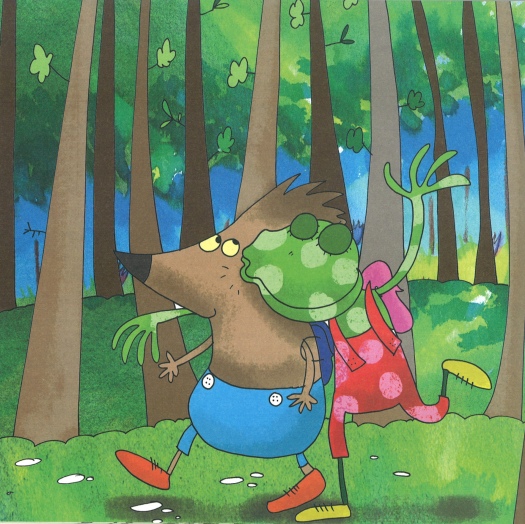
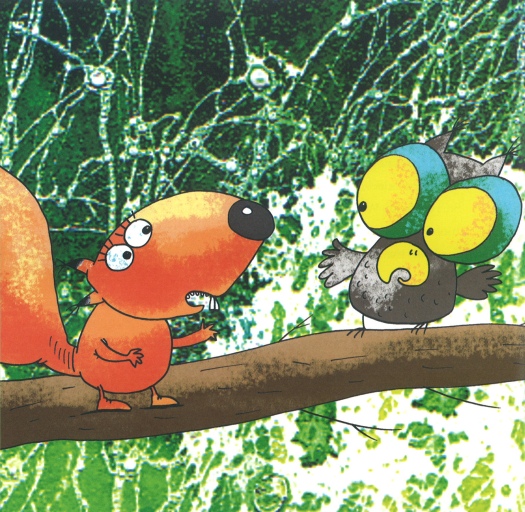
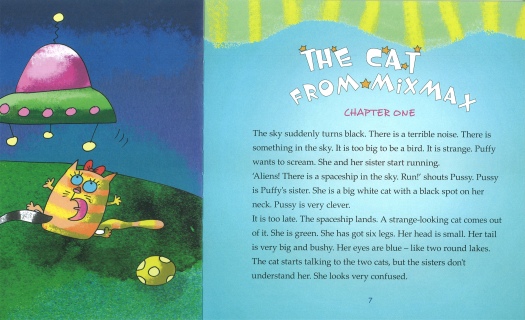
One important characteristic of these picturebooks are the pictures, i.e. the illustrations themselves. Each book is beautifully illustrated by Ivana Guljašević, my dear friend and a great artist. The interaction of the written text and illustrations plays an important role in conveying the meaning of the story. Ivana's illustrations always support the text. They captivate young readers' minds and make the stories even more attractive. The illustrations are, in general, essential to the story, since they give more significance to the words, reinforce the meaning and give aesthetic pleasure. The illustrations in this series cover only some parts of the text, but they are faithful to the plot, setting and characters as a whole. The colours are vivid and bright and the drawings are clear and positive. These illustrations can also be used as a useful resource for teachers who prefer using pictures in the language classroom. The cover story alone of any of these books can be the starting point for numerous speaking and writing activities.
It is not an easy task for an author to review his or her own book. The thorough review of Seven Animal Stories, written in 2007 by Mrs Smiljana Narančić Kovač, Assistant Professor at the Faculty of Teacher Education, University of Zagreb, approaches the Seven Animal Stories series from a different perspective and in a new light. Here are some excerpts from the review.
…The stories are interesting, witty, imaginative and cheerful.
… The author unobtrusively repeats target structures, vocabulary and phraseology in different ways, thus facilitating their easy acquisition. While doing so, the author uses more or less familiar children’s nursery rhymes and traditional songs of the English speaking world… All these interpolations and quotations are incorporated into the stories naturally….
… The author uses the English language naturally and freely, plays with it, its rhythm and phraseology and often uses rhymes. Her wittiness and creativity are best seen in the appropriate choice of names for the animal characters, i.e. Spikey for a hedgehog and Hopper for a frog.
…The post- reading activities, as well as the stories themselves, testify to the author’s creativity and to her experience in teaching English. They are varied and interesting, but the most prominent are rebuses and imaginative play with words, as well as rhyming pairs.
… To conclude, one can say that the series of books about animals written by Dragana Grozdanić is, for its attractiveness, freshness and methodical unobtrusive didacticism, primarily in the sense of learning English as a second language, but also for its educational value, a welcome novelty which will be gladly accepted by pupils and teachers alike.
I would just add that these books can be used by experienced teachers as well as teachers with little or no teaching experience. The former will have loads of ideas about what to do with these picturebooks, and the latter will be provided with many post-reading activities which mean that they will not have to spend hours preparing various activities and appropriate materials to make their lessons educational, interesting and fun. My teaching experience has taught me that these books can be successfully used as resources for role playing and drama classes or extra English classes. Therefore, I would like to hear from all those who are going to try or who have already tried any of the books from the Seven Animal Stories series in their classroom.

Please check the Creative Methodology for the Classroom course at Pilgrims website.
Please check the Methodology & Language for Kindergarten Teachers course at Pilgrims website.
Please check the Methodology & Language for Primary Teachers course at Pilgrims website.


|